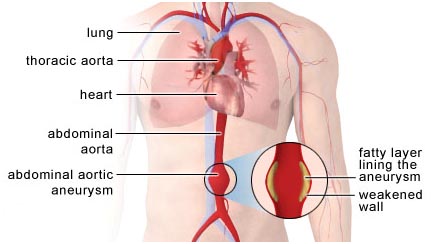The heart is one of the most vital organs in the human body. Question is:
Which cardiovascular conditions are the ones that need immediate medical care in order to prevent death? Much like the processor of a computer, or the engine of a motor vehicle, should anything goes wrong with the heart, the cardiovascular system in our body will be compromised and if not treated, the body can shut down.
However, there is a long list of various heart diseases.

Acute Coronary Syndromes
These syndromes include acute myocardial infarction or unstable angina. It is caused by sudden blockage of a coronary blood vessel resulting in reduced blood flow to the heart. This is usually due to sudden rupture of the atheroma (fatty plaque) in the artery which causes formation of clot.
 Symptoms
Symptoms
- Prolonged chest pain with crushing or heavy sensation
- Chest pain may radiate to the left arm
- Not relieved with rest
- Nausea and vomiting
- Profuse sweating
Diagnosis
- Electrocardiogram (ECG) shows characteristic changes
- Raised cardiac enzymes, such as Troponin I and CK-MB
- Clinical findings such as the character of chest pain
Treatment
- Blood thinning agent to  ease blood flow : E.g. aspirin, clopidogrel
- Vasodilators to relax blood vessels   : E.g. nitroglycerin (GTN)
- Clot-dissolving/thrombolytic agents : E.g. streptokinase, reteplase
- Percutaneous transluminal coronary angioplasty (PTCA) –  to open up the affected coronary artery and unblock it by inserting a balloon. Stenting may also be inserted to ensure better patency of the artery.
Acute Heart Failure: pulmonary edema
When the heart fails to function, usually due to left ventricular failure, blood cannot be circulated to the rest of the body.  This results in hypoxia of the main body organs such as the brain and kidneys. When these important organs and tissues do not receive enough oxygen as well as nutrients, they too, fail to function properly.
Symptoms
- Shortness of breath – Worsened when lying down, disturbing sleep; relieved on sitting up
- Swollen lower limbs
- Fatigue
- Chest pain
- Palpitation
Diagnosis
- Chest radiograph (X-ray) showing signs of pulmonary edema
- ECG may show signs of myocardial infarction or left ventricular dysfunction
- Raised B-type natriuretic peptides (BNP)
Treatment
- Sit the patient upright
- Oxygenation – consider ventilation if condition is severe
- Diuretics         : E.g. furosemide
- Vasodilators  : E.g. nitroglycerin
Now, the aorta being the largest artery in the body, is in charge of bringing blood supply to the other systems that are important for the human body to function normally. It is a main pipeline, so-to-speak, in the body in order for the other vital organs to work well. Below are two important and urgent conditions in relation to the damage of the aorta that can be life-threatening.
Aortic Dissection
This is caused by a tear in the intimal layer of the aortic wall resulting blood to flow within the layers of the arterial wall. Hence, a double-barreled aorta is formed. Affected
major branches arising from the aorta that supply other parts of the body will suffer from reduced blood flow and thus causing blood supply to the respective organs being compromised.

Symptoms
- Severe chest pain: characteristically stabbing nature and may radiate to the back
- Hypovolemic shock
Diagnosis
- Transesophageal echocardiogram
- CT angiography or MRI
Treatment
- Beta-blockers (orally or intravenously depending on measurement of blood pressure) – to reduce and control blood pressure for prevention of further dissection extension
- Surgery           – reconstitution of the aorta
Ruptured Aortic Aneurysm
Due to weakening of the aortic wall as a result of fatty deposits – atherosclerosis – a weak spot is developed in the aorta, forming a bulge. This can occur anywhere along the aorta but the two most common sites are the thoracic and abdominal aorta. Although aneurysm can grow silently and slowly over time, nonetheless, if this widening of the aorta progresses rapidly, a rupture or “burst†of this bulge can occur and this can be fatal. Hence it is an surgical emergency to treat a ruptured aortic aneurysm. It is difficult to predict the rate of which an aneurysm would grow.

Symptoms
- Can be symptomless if aneurysm is small
- Pain at site of aneurysm – E.g. chest, abdomen or back
- Difficulty in swallowing
- Syncope
- Palpable mass at site of aneurysm
Diagnosis
- Chest and/or abdominal radiograph (X-ray)
- Ultrasound scan – identification of an aneurysm and measurement of its size
- CT angiography or MRI – provide three-dimensional image of the aorta and determining the location of the aneurysm
- Echocardiogram – often used to screen family members with family history of aortic aneurysm
Treatment
- Medication     – In aneurysm that is not ruptured, blood pressure-reducing agent such as beta-blockers are prescribed to reduce the risk of expansion and rupture of the aneurysm
- Surgery       – A synthetic graft is used to patch up and reinforce the aorta
– Â Ruptured aneurysm requires immediate surgical repair of the aorta
– If the size of the aneurysm is 5.6cm or larger, surgery is recommended



